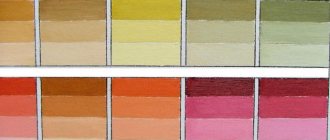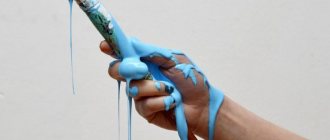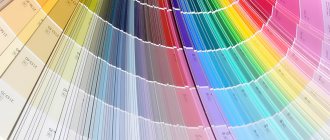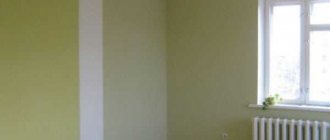Thanks to modern technologies, interior designers are becoming real wizards. In the blink of an eye, they will make any room stylish and original. Recently, more and more attention has been paid to color design. The most popular are non-standard shades that can be obtained by mixing colors.
Process Basics
Manufacturers of paints and varnishes presented a fairly wide range on the market. But it’s not always possible to choose what suits the interior perfectly. Combining several shades will help save time and money.
In many specialized stores you can use the services of a specialist who will help you make the desired color. But if you know the basic rules of how to mix dyes, you can do it yourself at home.
When mixing, you need to remember one important rule: you cannot combine liquid products with a dry mixture. They have different indices, so the coloring composition may eventually curdle.
The most interesting part of the process is creating the desired shade. There are four primary colors:
- white,
- blue,
- red,
- green.
By mixing them you can get any others. Here are some illustrative examples:
- You get brown if you combine red and green. To make a lighter shade, you can add a little white.
- Orange is the result of mixing yellow and red.
- If you need green, you need to combine yellow and blue paints.
- To get purple, you need to mix blue and red.
- Red and white will result in pink.
This way you can mix endlessly.
Production of blue pigment
Blue occurs widely in nature as a pigment in berries, fruits and flowers. By the way, you can get a natural dye from the same sources, for example, from blueberries, plum peels, eggplants, blackberries, etc. This method of producing color is quite labor-intensive and expensive, so it has not gained wide popularity.
On an industrial scale, blue pigment is obtained chemically from natural salts and metals. Thus, cobalt salts and aluminosilicates (ultramarine) make it possible to obtain beautiful shades from light to dark tones.
It is the chemical method of obtaining blue dye that allows you to enjoy a large selection of shades of paint on store shelves.
Mixing acrylic-based materials
Designers love acrylic paints the most. They are very easy to work with, and the finished coating has excellent water-repellent properties. Their use has several nuances:
- The working surface must be perfectly flat and smooth. To do this, it needs to be sanded.
- It is important that the paint does not dry out.
- To obtain an opaque color, use undiluted paint. Conversely, you can add a little water for transparency.
- To be able to quickly select the desired color, it is recommended to use a thinner for acrylic paints. Thanks to it, the product will not dry out so quickly.
- Use the edge of the brush to distribute the paint.
- Mixing is best done with a clean instrument. In this case, the colors should be directed towards each other.
- To make a light tone, you need to add white dye to the solution, and to get a dark one, add black. It is worth remembering that the palette of dark colors is much wider than light ones.
Here are some examples of mixing acrylic-based paints:
- Apricot color is obtained by mixing red, yellow, brown and white.
- The recipe for making beige paint involves combining brown and white. If you want a bright beige, you can add a little yellow. For a light beige shade you will need more white.
- Gold is the result of mixing yellow and red colors.
- Ocher is yellow and brown. By the way, it is considered popular this season.
- Khaki can be made by mixing green dye with brown.
- To get purple you need three different colors: red, yellow and blue.
Yellow and orange
Summer landscapes cannot be imagined without these shades.
Eggshell color
It can be conveyed if you add yellow and a drop of brown to white paint;
Mixing oil paints
Oil-based paints are more fluid, which necessitates more thorough mixing of the compositions if tones are mixed. The specificity and properties of oil colors provide the following advantages:
- the tone will be the most uniform, so the paint is perfect for decorating any surfaces,
- If desired, you can leave veins in the paint, which will allow you to create unusual effects on the canvas or wall.
Stirring the oil
Before work, it is important to evaluate whether it is possible to combine individual tones with each other, what will happen in the end. If you introduce a little glossy paint into matte paint, the result will be inexpressive. Adding matte paint to the shiny one helps make the latter a little more subdued.
You can mix paints using the following methods:
- Mechanical. In one container, on a palette, different colors are combined by mechanically mixing them. The saturation of the finished mass is adjusted by adding brighter or lighter shades.
- Optic. This method is practiced only by professionals. Paints are combined to produce a new color when applied to a canvas or wall.
- Color overlay. By layering strokes, a new tone is created.
Features of mixing paints
The mechanical method is the simplest, so it is recommended for beginners. When using color overlay, the result may differ from what was intended, which must be taken into account in advance. You can use the glaze method - first apply a darker color, then lighten it with strokes of light paint. It is better to practice combining oil paints in small portions, learn to create original effects, and then start creating paintings or interior decoration.
The working process
By mixing several different colors, you can get a large number of different shades. Which ones?
Shades of Gray
Quite often used in interior decoration. They help create shadow or unobtrusive color, as well as:
- You can create a regular gray by mixing black and white.
- To create cool shades, you need to add a little green to gray, and ocher for warm shades.
- Grey-green is gray with white and green.
- Gray-blue - gray, white and a little blue.
- Dark gray is the result of mixing gray and black.
Brown tones
To get a rich brown dye, you need to mix:
- green with red,
- red with blue and yellow,
- red with white, black and yellow.
How to create other original tones:
- You can get mustard if you add red, green and black dyes to yellow paint.
- Tobacco shade is red, green, yellow and white.
- Golden brown is the result of a combination of yellow, red, green, white and blue. In this case, there should be more yellow pigment.
Red tones
- The basis for the pink shade is considered to be white. Red is added to it. The brighter the desired shade, the more red you should add.
- To get a rich chestnut color, you need to mix red and black.
- Bright red-orange color - red and a little yellow. The more of the latter, the paler the result will be.
- You can give the dye a purple tint by mixing a few drops of bright blue and yellow colors and red pigment.
- To create raspberry, according to the recipe, you need to mix bright red + white + brown + blue. The more white, the pinker the hue.
Green tones
Deep green color is formed by combining yellow and blue tones. The saturation of the finished dye depends on the amount of each of them. To create shades, you need to add other colors to green:
- For mint you will need white.
- To obtain an olive color you need green and a few drops of yellow.
- The shade of grass can be obtained by mixing green with blue. Yellow paint will help to even out the color.
- The color of the needles is the result of mixing green with black and yellow.
- Gradually mixing green with white and yellow, you can create an emerald tone.
Violet tones
Purple is made by mixing blue and red. You can also use blue and pink paints - the final color will be light, pastel. To darken the finished tone, artists use black paint, which is added in very small portions. Here are the nuances for creating shades of purple:
- for light purple, you can dilute the finished color with white in the required ratio,
- For purple, you need to add more red paint than blue.
Orange color
When creating classic orange, combine one part of yellow and red paint. But for many types of paint you have to use more yellow, otherwise the color will turn out too dark. Here are the main shades of orange and how to get them:
- for light orange use pink and yellow, you can also add a little white paint,
- for coral you need dark orange, pink, white in equal proportions,
- for peach you need colors such as orange, yellow, pink, white,
- for red, you need to take dark orange and a little brown.
How does the color of a light source change as its temperature increases?
Thus, as the temperature of the light source increases, the tonality of the emitted light changes from red to blue, that is, it passes through the white color spectrum, and can convey the exact shade of the sun at any point in the sky, even taking into account cloudiness.
Interesting materials:
How can you remove wires from your dog? How can you remove stretch marks on your butt? How can you decorate your home for the New Year? How can you quit without working according to the law? How can you find out your legal debt? How can you find out your TIN on the Internet? How can I get my shirt back to white? How can I keep a purchase book? How can you straighten a cap? How can you dry a carpet?
Important rule
Many people ask the question: is it possible to mix paints and varnishes from different manufacturers? It is advisable that the dyes being mixed are manufactured by the same company. It's even better if they come from the same batch. It is not recommended to mix dyes from different companies. They often have different properties, such as density, brightness, etc. Because of this, the finished coating may curl.
If you want to take a risk, you can combine a little bit of one and the other paint and apply the resulting solution to the surface. If it thickens or clumps, the experiment is a failure.
Light green
So we know what colors to mix to make green. But how to clarify the result? Just add white. For classic light green, the proportions are 2:1:1. That is, there is 2 times more white. The resulting warm shade can be varied. More white – the paint becomes lighter. Less - it is juicier. This produces different shades, from soft pastel to cheerful bright green.
You can do it differently and replace blue with light blue. As a result, we have the same light green paint. In this case, you can change the brightness by varying the proportions of blue.
Computer help
You can correctly mix several colors using special computer programs. They help you see the final result and determine in percentage terms how much of a particular tone needs to be added. Such programs will help you figure out what shade you can get from the products that are available. They consist of several elements:
- A button that removes tones from the set.
- Color names.
- Lines of input or output to or from a calculation.
- Samples.
- A button that introduces colors into a set.
- Result windows.
- New selection window and list.
- Composition of the finished dye in percentage terms.
Mixing several different colors is a fairly common technique among designers. Unusual shades will help to decorate the interior favorably, make it original or even unique. You can even mix dyes at home. There are many recipes for creating one shade or another. For example, to get beige you need to combine white and brown, and to get pink you need to combine white and red.
It is recommended to always have a thinner on hand that will prevent the paint from drying out quickly. You should not mix products from different manufacturers, because the result will be a poor-quality coating. To find out the final result of mixing, you can use a special computer program.
About receiving flowers
For pictorial art, you can vary the tonality using gouache countless times, this is necessary for the artist to show the corresponding details in a different way.
A number of tips for the artist:











